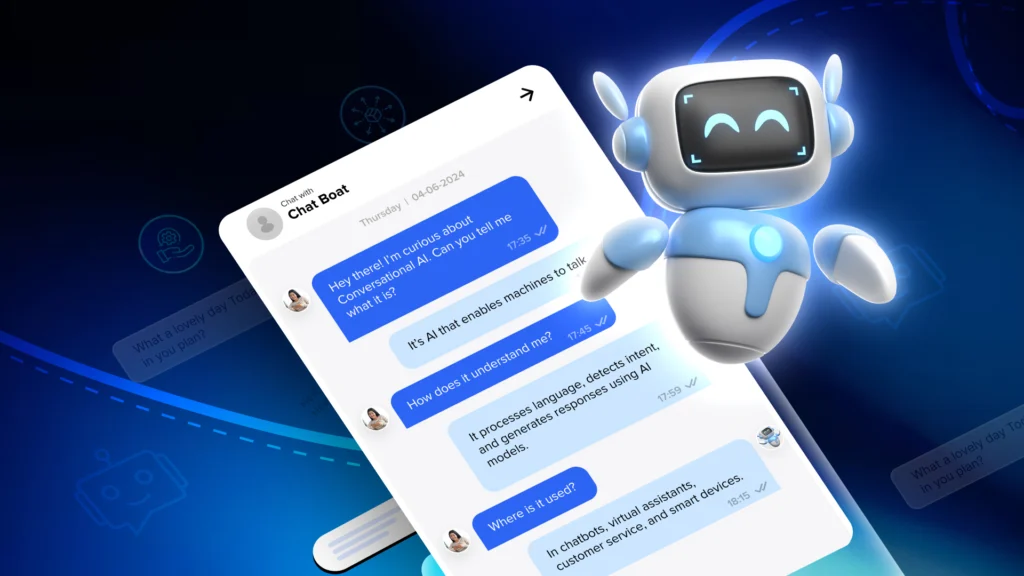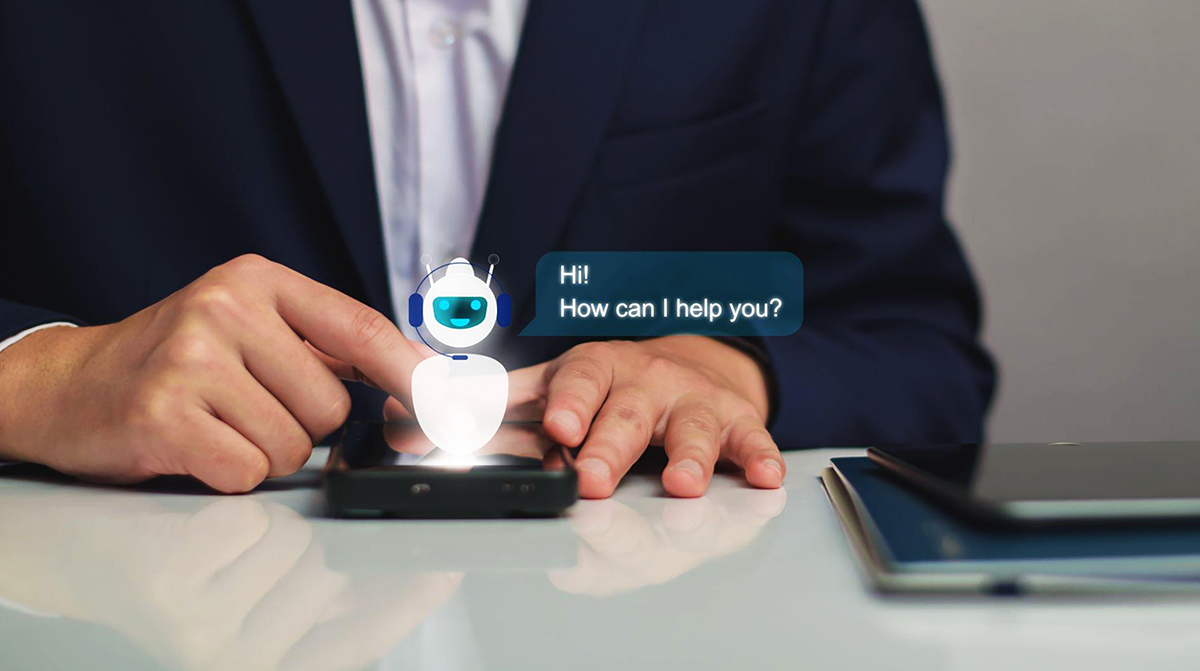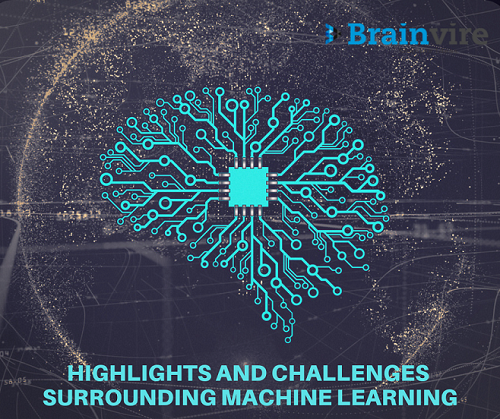We have seen a tremendous shift in artificial intelligence in the last several years, especially in conversational bots. Thanks to advancements in Large Language Models (LLMs), Conversational AI has emerged, paving the way for more engaging and human-like interactions between computers and people. There are a lot of potential uses for this technological paradigm shift, which promises scalable, asynchronous, and inexpensive communication.
Language learning models (LLMs) mimic human interaction dynamics by analyzing and producing text in a context-relevant way. They can mimic different accents and levels of verbosity, adjust to the circumstances of a discussion, and come up with original replies.
Using what you learn in this tutorial, you can create a simple chatbot with a personality and knowledge base that exceeds what these bots currently provide.
Understanding Chatbots
Chatbots have revolutionized digital communication by enabling automated, real-time interactions between businesses and users. A chatbot is an AI-driven software application designed to simulate human-like conversations, interpret user inputs, and provide relevant responses. They can be integrated across websites, messaging platforms, and mobile applications to enhance customer engagement, automate responses, and improve customer service efficiency.
By leveraging artificial intelligence, natural language processing (NLP), and machine learning services, chatbots can handle various queries, assist in decision-making, and provide seamless customer experiences. Businesses use chatbots to streamline operations, reduce human workload, and offer instant user support, improving satisfaction and engagement.

Types of Chatbots
| Type | Description |
| Rule-based Chatbots | Operate on predefined rules and responses |
| AI-powered Chatbots | Utilize NLP and machine learning to improve over time |
| Hybrid Chatbots | Combine rule-based and AI capabilities for flexibility |
Rule-Based Chatbots
Chatbots that are based on rules can respond to user queries in a predetermined way by referring to decision trees and previously set rules. Such chatbots are limited to answering questions from their pre-programmed knowledge base and operate according to a predetermined process. They function effectively for simple, repetitive tasks like appointment scheduling, basic troubleshooting, and frequently asked questions (FAQs).
Instead of learning from encounters, these chatbots evaluate user requests using if-then logic. They work well for simple tasks, but they can’t comprehend more complicated questions or recognize context beyond their pre-programmed answers.

Examples:
- Automated customer support chatbots for order tracking
- Banking chatbots for balance inquiries and transaction history
- E-commerce bots for answering frequently asked questions
AI-Powered Chatbots
Chatbots powered by artificial intelligence (AI) learn from users’ interactions using natural language processing (NLP) and ML algorithms. Bots may analyze conversational patterns, which allows them to learn from previous encounters and provide more contextually relevant replies than rule-based chatbots.
These chatbots may handle more sophisticated questions and even give individualized suggestions depending on user actions. They find widespread applications in interactive marketing, virtual assistants, and customer service.
Examples:
- Virtual assistants like Siri, Alexa, and Google Assistant.
- AI chatbots for customer service that provide personalized recommendations.
- Healthcare bots that analyze symptoms and suggest medical guidance.
Hybrid Chatbots
Consider a hybrid model combining rule-based and AI-powered features for a more versatile and satisfying chatbot experience. These chatbots use AI components to answer more complicated inquiries and follow predetermined rules for organized conversations. Hybrid chatbots are popular among businesses because they allow for continuously improving AI-based automation while maintaining efficiency and scalability.
With hybrid chatbots, businesses can begin with rule-based interactions and gradually add AI-driven improvements, guaranteeing a smooth upgrade. This strategy will be appropriate for organizations that require defined procedures and AI-driven solutions’ flexibility.
Examples:
- Customer service bots that escalate issues to human agents when necessary.
- E-commerce bots that use AI to suggest products but follow predefined checkout processes.
- Banking chatbots that provide both automated responses and AI-powered financial advice.
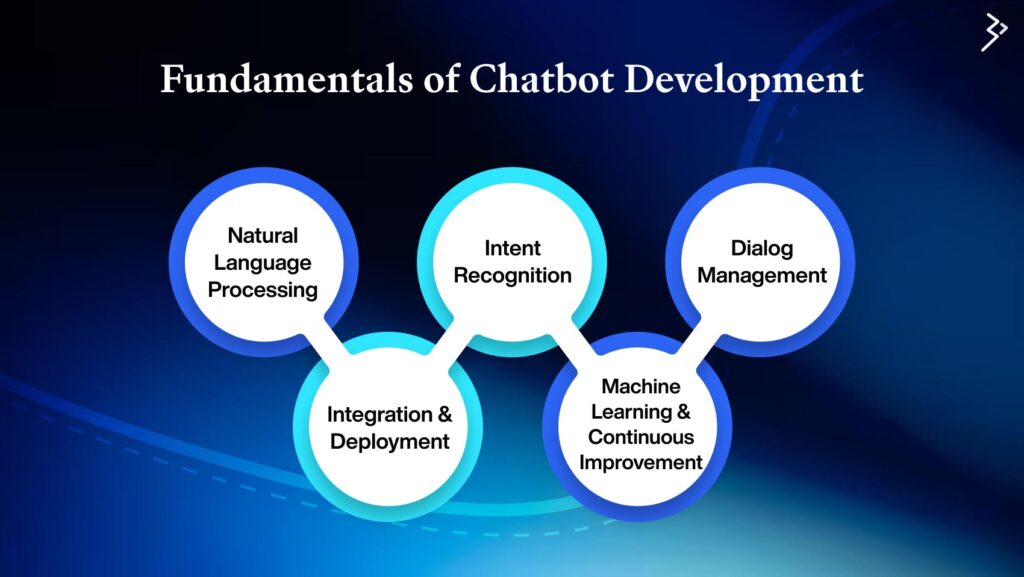
Fundamentals of Chatbot Development
Chatbots have revolutionized customer interactions by providing instant, automated responses to queries. These AI-powered assistants are widely used across industries, from customer support and healthcare to eCommerce and finance. Developing an effective chatbot involves understanding key principles and components that ensure seamless communication and user engagement.
Natural Language Processing (NLP)
Natural Language Processing (NLP) is the backbone of chatbot development. It enables chatbots to understand, interpret, and process human language. NLP comprises:
- Tokenization: Breaking down text into smaller components like words and phrases.
- Named Entity Recognition (NER): Identifying key elements in a sentence, such as dates, names, and locations.
- Sentiment Analysis: Determining the user’s emotion behind a message.
- Part-of-Speech (POS) Tagging: Understanding the grammatical role of words in a sentence.
NLP helps a chatbot process user queries accurately, ensuring meaningful and context-aware interactions.
Read More-: Best Free AI Presentation Maker Tools for 2025
Intent Recognition
Intent recognition is the process of identifying what a user wants to achieve through a conversation. By analyzing the input text, chatbots can determine the intent behind a query, such as booking a ticket, requesting support, or checking product details. Machine learning models trained on diverse datasets help improve intent recognition accuracy over time, making chatbots more efficient.
Dialog Management
Adequate conversation flow is crucial in chatbot interactions. Dialog management ensures that chatbots:
- Maintain context throughout the conversation
- Handle multi-turn interactions efficiently
- Generate appropriate responses based on user input
There are two main types of dialog management:
- Rule-Based Dialogs: Predefined decision trees where responses are based on a fixed structure.
- AI-Driven Dialogs: Dynamic responses generated using deep learning models that adapt to various conversation styles.
A well-designed dialog system makes chatbot interactions smoother and more intuitive for users.
Integration & Deployment
For a chatbot to be effective, it must be accessible across multiple platforms. Integration involves:
- Website Chat Widgets: Embedding chatbots into business websites for real-time customer support.
- Messaging Apps: Deploying chatbots on platforms like WhatsApp, Facebook Messenger, and Telegram.
- Customer Service Portals: Integrating with CRM systems like Salesforce and Zendesk to automate ticket handling.
- Voice Assistants: Enabling voice-based interactions on Alexa, Google Assistant, and Siri.
API-based integrations allow chatbots to connect with databases, third-party tools, and business applications, enhancing functionality and user experience.
Machine Learning & Continuous Improvement
A chatbot’s effectiveness depends on its ability to learn and improve over time. By leveraging machine learning techniques, chatbots can:
- Analyze past conversations to refine responses
- Adapt to different languages and communication styles
- Identify common issues and provide proactive solutions
Regular training and fine-tuning of chatbot models ensure continuous performance enhancement.
Read More-: Top AI Marketing Tools We’re Using to Get Ahead in 2025
Step-by-Step Guide to Building a Basic Chatbot
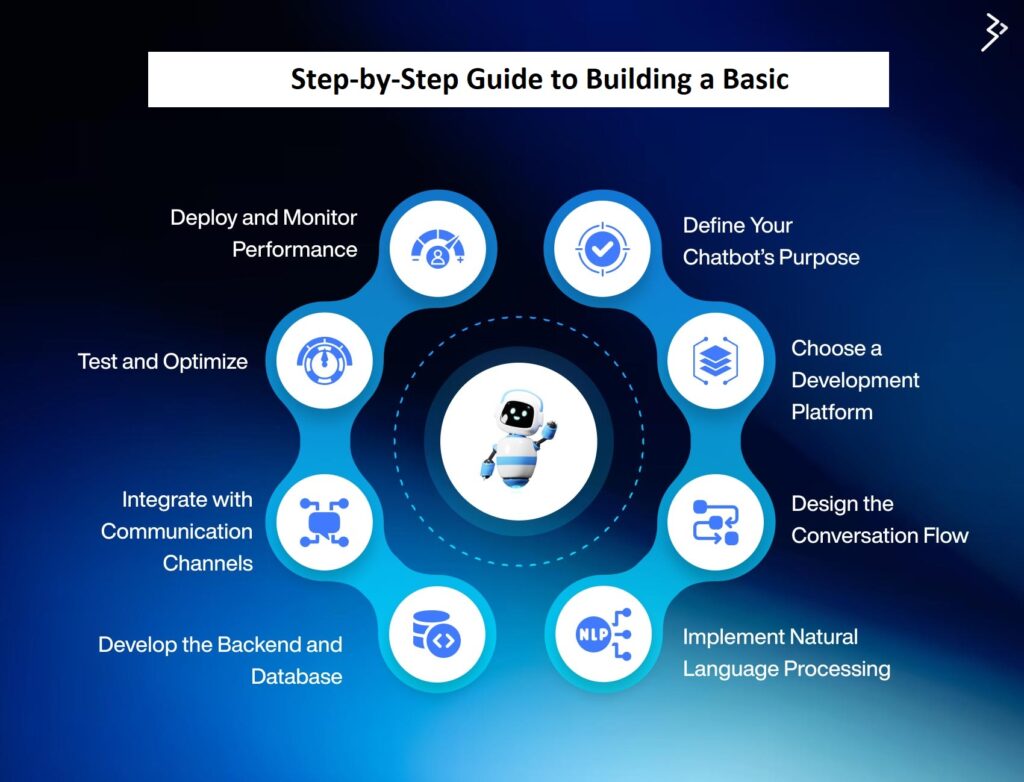
Chatbots have become essential for businesses, offering automated assistance and improving customer engagement. Building a basic chatbot involves several crucial steps, from selecting the right framework to deploying it on various platforms. Here’s a step-by-step guide to creating a functional chatbot.
Step 1: Define Your Chatbot’s Purpose
Before development begins, clearly outline the chatbot’s objectives. Determine:
- The primary function (e.g., customer support, FAQs, appointment booking).
- The target audience and their expected queries.
- The level of AI sophistication required (rule-based or AI-driven).
Defining the chatbot’s purpose ensures a focused and efficient development process.
Step 2: Choose a Development Platform
Selecting the right chatbot-building framework simplifies development. Popular platforms include:
- Dialogflow (Google) – NLP-powered chatbot creation
- Microsoft Bot Framework – Scalable and integrated with Azure
- IBM Watson Assistant – AI-driven chatbot with strong analytics
- Rasa – Open-source framework for advanced AI chatbots
These platforms offer pre-built functionalities, reducing coding effort.
Step 3: Design the Conversation Flow
A chatbot must follow a structured conversation flow. Consider:
- Greeting users with a welcome message
- Recognizing intents and mapping them to responses
- Handling small talk and fallback responses for unclear inputs
- Ending conversations naturally or redirecting users to human support
Flowcharts or conversation design tools like Botsociety can help visualize interactions.
Step 4: Implement Natural Language Processing (NLP)
NLP allows chatbots to understand human language. It includes:
- Intent Recognition: Identifying user requests (e.g., “Check order status”)
- Entity Extraction: Identifying relevant data like dates and locations
- Context Management: Maintaining continuity in multi-turn conversations
Using NLP engines like Google Dialogflow or IBM Watson Assistant enhances chatbot comprehension.
Step 5: Develop the Backend and Database
The chatbot requires a backend to process requests and store data. Key components include:
- APIs to fetch data from external sources
- Databases (e.g., MySQL, Firebase) to store conversation history
- Webhook Integrations for real-time updates and automation
A robust backend ensures a smooth and scalable chatbot experience.
Step 6: Integrate with Communication Channels
Deploying the chatbot on different platforms improves accessibility. Common integrations include:
- Websites (via chat widgets)
- Messaging Apps (WhatsApp, Facebook Messenger, Telegram)
- Mobile Apps (through in-app chat features)
- Voice Assistants (Alexa, Google Assistant)
Using APIs, developers can seamlessly connect chatbots to multiple communication channels.
Step 7: Test and Optimize
Thorough testing is essential before deployment. Conduct:
- Unit Testing: Ensuring each function works correctly
- User Testing: Gathering real-world feedback
- Performance Testing: Checking response time and scalability
Improving and updating the chatbot makes the user experience better.
Step 8: Deploy and Monitor Performance
Once tested, deploy the chatbot and track its performance using analytics tools. Key metrics to monitor include:
- User engagement and satisfaction rates
- Commonly asked questions
- Areas where the chatbot struggles (for improvements)
Regular updates and AI model refinements help maintain chatbot efficiency.
Read More-: Chatbots and Their Impact on Customer Support

Best Practices for Chatbot Development
Chatbots have emerged as vital resources for companies aiming to boost customer interaction and optimize communication. However, a poorly designed chatbot can frustrate users rather than assist them. Here are the best practices for chatbot development to ensure an effective chatbot experience.
1. Design for Simplicity
A well-designed chatbot should provide a seamless user experience. Keeping interactions simple and intuitive helps users find information quickly without unnecessary confusion. Best practices include:
- Using short, clear, and direct responses to prevent overwhelming users
- Offering structured choices where possible to guide users effectively
- Avoiding jargon or overly technical language to ensure accessibility
Simplicity ensures users can navigate conversations effortlessly, leading to higher engagement and satisfaction.
2. Ensure Context Awareness
A chatbot should be able to remember past interactions to provide meaningful responses. Context awareness enhances user experience by making conversations feel natural. Key strategies include:
- Implementing memory and session tracking to retain relevant details throughout a conversation
- Enabling multi-turn dialogues to handle complex queries efficiently
- Using AI-powered Natural Language Processing (NLP) to recognize context and intent
Chatbots can offer more coherent and intelligent responses by maintaining context, and improving overall usability.
3. Provide Fallback Responses
No chatbot can handle every possible query, so it’s essential to have fallback mechanisms in place. A well-planned fallback strategy ensures users are not left without assistance. Best practices include:
- Designing error-handling responses that acknowledge confusion while guiding users to a solution.
- Providing suggested questions or topics when the chatbot doesn’t understand an input.
- Offering a seamless transition to human support for more complex issues.
With an effective fallback system, users will feel supported even when the chatbot encounters unfamiliar inputs.
4. Use Personalization
Personalized interactions improve user engagement and make chatbot interactions more meaningful. Tailoring responses based on user data can enhance the chatbot’s effectiveness. Key approaches include:
- Implementing user profiles to remember preferences and past interactions.
- Customizing responses based on location, language, and user behavior.
- Using AI-driven recommendations to provide relevant suggestions and solutions.
A personalized experience makes users feel valued and increases the likelihood of continued interaction with the chatbot.
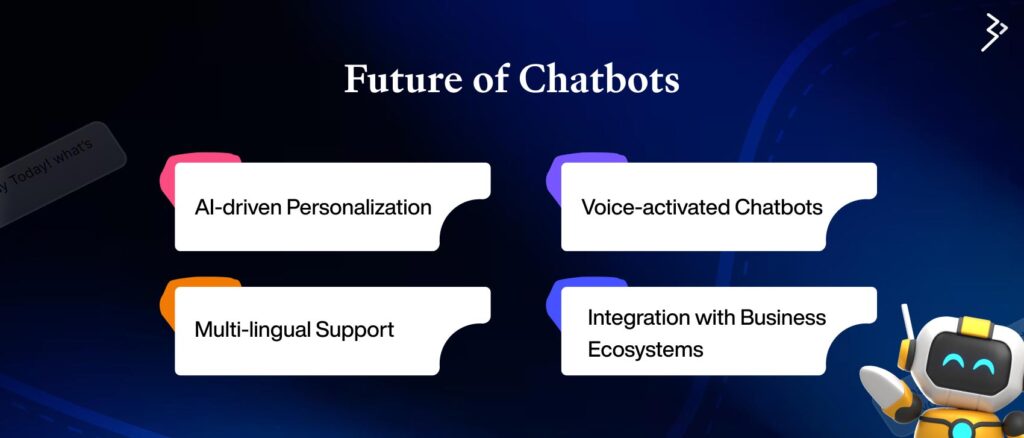
Future of Chatbots
Chatbots are rapidly evolving, becoming more intelligent and versatile. With advancements in AI, the future of chatbots promises more intuitive, human-like interactions and expanded capabilities. Here’s what we can expect:
AI-driven Personalization
Future chatbots will leverage advanced artificial intelligence and machine learning to deliver highly personalized experiences. Chatbots will offer tailored recommendations, responses, and proactive support by analyzing user behavior, preferences, and past interactions. This will create more engaging and effective interactions, making chatbots feel more human-like.
Voice-activated Chatbots
As voice technology grows, chatbots will increasingly integrate with smart assistants like Alexa, Google Assistant, and Siri. Voice-activated chatbots will allow users to interact naturally, making them more accessible and efficient for scheduling, online shopping, and customer support tasks. Improved speech recognition will enable smoother and more accurate voice-based conversations.
Multi-lingual Support
Enhanced Natural Language Processing (NLP) models will enable chatbots to fluently support multiple languages. This advancement will help businesses engage with a global audience by offering seamless, real-time translations and culturally adaptive interactions. Improved language understanding will reduce miscommunication and enhance user satisfaction.
Integration with Business Ecosystems
Future chatbots will be deeply integrated into business operations, providing automated customer support, sales assistance, and workflow management. They will work alongside CRMs, ERPs, and eCommerce platforms to enhance efficiency and user engagement.
Wrap Up
Building a chatbot requires understanding NLP, intent recognition, and best practices for user-friendly interactions. With advancements in AI and automation, chatbots will continue evolving, offering businesses a powerful tool for engaging customers and improving operational efficiency. Whether using Azure Bot Service or Microsoft Bot Framework, developing a chatbot begins with the right approach and focusing on enhancing user experience.
Related Articles
-
3 Ways Machine Learning is Making a Difference in the Healthcare Industry
The IT industry is constantly on the lookout for improvements and innovations in any of the codes that the developers write down on a daily basis. Improvements and innovations consume
-
Best Gen-AI-Based Customer Service Chatbots
In 2025, businesses will increasingly turn to Generative AI-based customer service chatbots to provide seamless and personalized customer experiences. These chatbots leverage advanced natural language processing (NLP) and AI algorithms
-
Highlights and Challenges surrounding Machine Learning
Machine Learning, yes, this word might have flooded your mind with a number of questions, so here we are with answers to them by highlighting the advantages and disadvantages of

